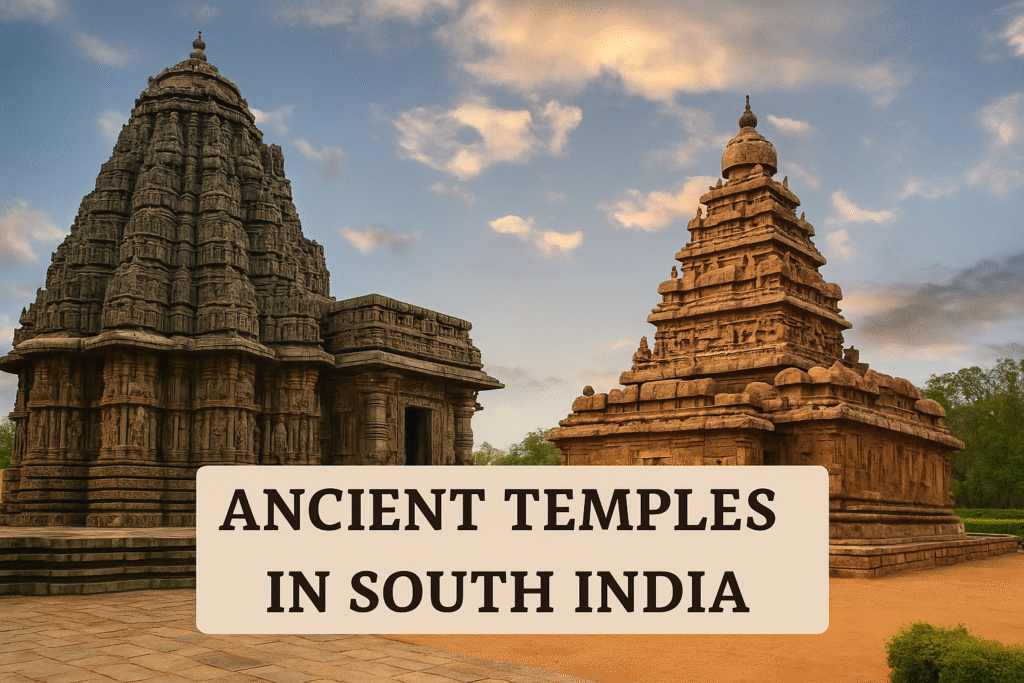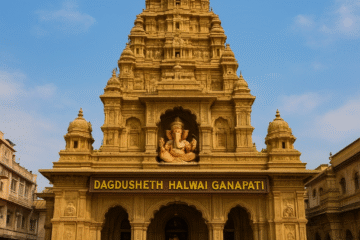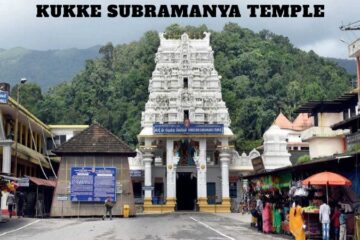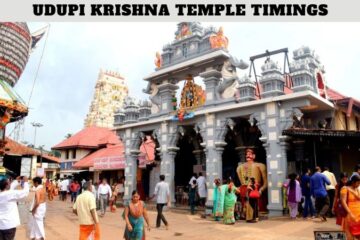
Table of Contents
South India, a land steeped in rich history and vibrant culture, is perhaps best known for its awe-inspiring temple architecture. These aren’t merely places of worship; they are monumental testaments to human ingenuity, artistic brilliance, and unwavering devotion. The ancient temples in South India stand as living museums, narrating tales of powerful empires, intricate craftsmanship, and profound spiritual beliefs that have shaped the region for millennia. From the rock-cut wonders of the Pallavas to the towering gopurams of the Cholas and the sprawling complexes of the Vijayanagara Empire, each temple is a unique chapter in the grand saga of Indian heritage.
The architectural style predominantly found in South India is known as Dravidian architecture, characterized by its distinctive features like pyramidal multi-storied towers (vimanas), massive gateway towers (gopurams), pillared halls (mandapams), and elaborate courtyards (prakaras). These structures are not just buildings but cosmic diagrams, designed to elevate the human spirit and connect with the divine. This exploration delves into the history, architectural marvels, and cultural significance of some of the most prominent ancient temples in South India, offering a glimpse into a civilization that mastered the art of building with stone and spirit.
The Dawn of Dravidian Architecture: The Pallava Legacy (6th-9th Century CE)
The Pallava dynasty laid the foundational stones for Dravidian temple architecture. Their early experiments involved rock-cut caves and monolithic temples, gradually evolving into structural temples. Mahabalipuram (Mamallapuram), a UNESCO World Heritage site on the Coromandel Coast, is a prime example of their innovative spirit.
The Shore Temple at Mahabalipuram, built in the 8th century CE, is one of the earliest structural stone temples in South India. Overlooking the Bay of Bengal, its twin shrines dedicated to Shiva and Vishnu, along with a smaller shrine, showcase the transition from rock-cut to freestanding architecture. Its intricate carvings, though weathered by centuries of sea breeze, still depict deities, animals, and mythological scenes, reflecting the Pallava mastery of sculpture. The temple’s unique location and its blend of shrines make it a significant landmark among the ancient temples in South India.
Equally remarkable are the Five Rathas (Pancha Rathas) – five monolithic temples carved out of single granite boulders, each resembling a chariot. Named after the Pandavas and Draupadi from the Mahabharata, these structures (Dharmaraja Ratha, Bhima Ratha, Arjuna Ratha, Nakula-Sahadeva Ratha, and Draupadi Ratha) represent different architectural styles and provide invaluable insights into the early stages of temple design. They are a sculptor’s dream, showcasing various forms of vimanas, columns, and decorative motifs.
Further inland, in Kanchipuram, the Pallavas continued their architectural prowess. The Kailasanathar Temple, built by King Rajasimha (Narasimhavarman II) in the early 8th century, is a magnificent structural temple dedicated to Shiva. It is renowned for its exquisite sculptures, including numerous panels depicting Shiva’s cosmic dance (Nataraja) and other mythological narratives. The temple’s sandstone construction, intricate carvings, and the presence of a circumambulatory passage with smaller shrines make it a jewel of Pallava art. The Vaikuntha Perumal Temple, also in Kanchipuram, dedicated to Vishnu, showcases a unique three-tiered vimana and narrative panels depicting the history of the Pallava dynasty, serving as both a religious edifice and a historical chronicle. These Kanchipuram temples are crucial examples when discussing the ancient temples in South India.
The Zenith of Grandeur: The Chola Empire (9th-13th Century CE)
The Chola dynasty, one of the longest-ruling dynasties in South Indian history, took temple building to unprecedented heights, creating colossal structures that remain architectural marvels to this day. Their temples are characterized by their massive scale, soaring vimanas, and bronze sculptures of unparalleled beauty. The “Great Living Chola Temples,” a UNESCO World Heritage site, epitomize their architectural genius.
The Brihadeeswarar Temple in Thanjavur, built by Emperor Rajaraja I in the early 11th century, is the crowning glory of Chola architecture and arguably one of the most magnificent ancient temples in South India. Dedicated to Lord Shiva, this monumental structure boasts a 60-meter-high vimana, a towering pyramid-like structure carved from a single piece of granite (a feat of engineering that still baffles experts). The temple complex includes a massive Nandi (bull) statue, intricate frescoes, and a sophisticated system of inscriptions detailing the temple’s history and administration. The precision of its construction, the grandeur of its scale, and the artistic finesse of its sculptures make it a timeless masterpiece.
Following in the footsteps of his father, Rajendra I built the Gangaikondacholapuram Temple in the 11th century to commemorate his victory over the northern kingdoms. While slightly smaller than the Thanjavur temple, it shares a similar architectural style and is equally impressive. Its graceful curves, intricate carvings, and the unique lion-headed well (Simhakeni) add to its charm. The temple also features a massive Nandi and a large Lingam, reflecting the Chola’s unwavering devotion to Shiva.
The third of the Great Living Chola Temples is the Airavatesvara Temple at Darasuram, built by Rajaraja II in the 12th century. This temple is smaller in scale but exceptionally rich in sculptural detail, often described as a “sculptor’s dream.” It features exquisite carvings depicting mythological stories, celestial dancers, and musical instruments. The highlight is the unique stone chariot, complete with carved wheels and horses, which forms part of the mandapam. The musical pillars, which produce different notes when tapped, are another testament to the Chola’s advanced understanding of acoustics and stone carving. These Chola temples collectively represent the pinnacle of temple construction among the ancient temples in South India.
The Flourishing of Gopurams: The Pandyas and Beyond (13th-14th Century CE)
While the Pandyas also contributed significantly to temple building, their most notable contribution lies in the development and embellishment of the gopurams (gateway towers). They transformed these gateways into colossal, multi-storied structures adorned with a riot of sculptures, making them the most prominent feature of the temple complex.
The Meenakshi Amman Temple in Madurai, though having origins dating back to antiquity, saw its current magnificent form largely shaped by the Nayaka rulers (successors to the Pandyas and Vijayanagara). However, the Pandya influence on its early gopurams and overall layout is undeniable. This sprawling temple complex, dedicated to Goddess Meenakshi and Lord Sundareswarar (Shiva), is a vibrant hub of religious activity and artistic expression. Its 14 towering gopurams, each adorned with thousands of brightly painted mythological figures, are a visual spectacle. The Hall of Thousand Pillars, with its intricately carved columns, and the sacred Golden Lotus Pond are other highlights. The Meenakshi Amman Temple stands as a testament to the continuous evolution and grandeur of the ancient temples in South India.
The Grandeur of the Last Great Empire: Vijayanagara (14th-16th Century CE)
The Vijayanagara Empire, the last great Hindu empire in South India, inherited and expanded upon the architectural traditions of its predecessors. Their capital, Hampi (a UNESCO World Heritage site), is a sprawling ruin of magnificent temples, palaces, and public structures, reflecting the empire’s immense wealth and artistic patronage. Vijayanagara architecture is characterized by its emphasis on elaborate pillared mandapams, large temple complexes, and unique features like musical pillars and stone chariots.
The Virupaksha Temple in Hampi, dedicated to Lord Virupaksha (a form of Shiva), has been a continuous place of worship since the 7th century, though its current form was largely developed under the Vijayanagara rulers. Its towering gopuram, intricate carvings, and the presence of a sacred elephant are notable features. The temple’s location amidst the surreal boulder-strewn landscape adds to its mystique.
The Vittala Temple complex in Hampi is perhaps the most iconic example of Vijayanagara architecture. Dedicated to Lord Vittala (a form of Vishnu), this temple is famous for its extraordinary stone chariot, a meticulously carved monolithic structure that has become a symbol of Hampi. The temple’s “musical pillars” in the Ranga Mandapa, which resonate with different musical notes when tapped, showcase the advanced acoustic knowledge of the builders. The intricate carvings depicting scenes from the Ramayana and Mahabharata, as well as daily life, are breathtaking. The Vittala Temple, along with other structures in Hampi, represents a distinct and glorious chapter in the history of ancient temples in South India.
Beyond the Dynasties: Chera and Other Influences
While Pallava, Chola, Pandya, and Vijayanagara empires dominated the architectural landscape, other regional kingdoms also contributed to the rich tapestry of South Indian temples. The Chera dynasty, primarily in present-day Kerala, developed a unique architectural style characterized by wooden structures, multi-tiered roofs, and a focus on circular or square sanctums. Though many early wooden temples have not survived the ravages of time, their influence can be seen in later stone structures and the distinct temple architecture of Kerala.
The Enduring Significance of Ancient Temples in South India
The ancient temples in South India are far more than just architectural marvels; they are vibrant centers of culture, art, and spiritual life.
Religious and Spiritual Hubs: These temples continue to be active places of worship, drawing millions of devotees annually. They are central to the religious identity of South India, hosting festivals, rituals, and ceremonies that have been performed for centuries.
Artistic and Cultural Repositories: The walls, pillars, and ceilings of these temples are adorned with a bewildering array of sculptures, frescoes, and paintings. They depict mythological narratives, divine forms, celestial beings, dancers, musicians, and scenes from daily life, offering a comprehensive visual encyclopedia of ancient Indian culture. They served as schools for art, dance (Bharatanatyam has strong ties to temple traditions), and music.
Engineering and Scientific Achievements: The construction of these massive structures, often without the aid of modern machinery, points to an advanced understanding of engineering, materials science, and acoustics. The precise alignment of temples with cardinal directions, the intricate water management systems within temple tanks, and the “musical” properties of certain pillars demonstrate a sophisticated knowledge base.
Social and Economic Centers: In ancient times, temples were not just religious sites but also economic powerhouses and social institutions. They owned vast lands, employed numerous people, and served as centers for education, healthcare, and community gatherings. They played a crucial role in the local economy and social fabric.
Historical Records: The numerous inscriptions found on temple walls provide invaluable historical data, detailing royal genealogies, military victories, administrative decrees, land grants, and societal norms. They are primary sources for reconstructing the history of South Indian dynasties.
Architectural Evolution: The progression from rock-cut caves to monolithic structures, and then to colossal structural temples with towering gopurams, showcases a continuous evolution of architectural styles and techniques. Each dynasty added its unique flavor, refining and expanding upon existing traditions.
Conclusion: A Timeless Legacy
The ancient temples in South India stand as a magnificent testament to a civilization that harmoniously blended art, religion, engineering, and culture. They are not merely relics of the past but living monuments that continue to inspire awe and devotion. Visiting these temples is a journey through time, offering a profound appreciation for the artistic genius, spiritual depth, and architectural prowess of the bygone eras. Their enduring presence reminds us of the rich tapestry of Indian heritage and the timeless human quest for the divine, etched in stone for eternity. As custodians of this invaluable legacy, it is imperative that we cherish and preserve these architectural wonders for generations to come.
Frequently Asked Questions (FAQs)
1. What is the predominant architectural style of ancient temples in South India?
Ans. The predominant architectural style is known as Dravidian architecture.
2. What are the key characteristics of Dravidian architecture?
Ans. Dravidian architecture is characterized by features such as pyramidal multi-storied towers (vimanas), massive gateway towers (gopurams), pillared halls (mandapams), and elaborate courtyards (prakaras).
3. Which dynasty is credited with laying the foundational stones for Dravidian temple architecture?
Ans. The Pallava dynasty (6th-9th Century CE) is credited with laying the foundational stones for Dravidian temple architecture.
4. Name some significant Pallava temples mentioned in the text.
Ans. Significant Pallava temples include the Shore Temple and the Five Rathas (Pancha Rathas) in Mahabalipuram, and the Kailasanathar Temple and Vaikuntha Perumal Temple in Kanchipuram.
5. Which Chola temple is considered the crowning glory of Chola architecture?
Ans. The Brihadeeswarar Temple in Thanjavur, built by Emperor Rajaraja I, is considered the crowning glory of Chola architecture.
6. What are the “Great Living Chola Temples”?
Ans. The “Great Living Chola Temples” are a UNESCO World Heritage site comprising the Brihadeeswarar Temple in Thanjavur, the Gangaikondacholapuram Temple, and the Airavatesvara Temple at Darasuram.
7. What was the significant contribution of the Pandya dynasty to temple architecture?
Ans. The Pandyas’ most notable contribution was the development and embellishment of the colossal, multi-storied gopurams (gateway towers).
8. Which famous temple in Madurai showcases the grandeur of gopurams?
Ans. The Meenakshi Amman Temple in Madurai is famous for its 14 towering gopurams, largely shaped by the Nayaka rulers with undeniable Pandya influence.
9. What are some unique features of Vijayanagara architecture, as seen in Hampi?
Ans. Vijayanagara architecture emphasizes elaborate pillared mandapams, large temple complexes, and unique features like musical pillars and stone chariots, exemplified by the Vittala Temple.
10. Besides their religious function, what other roles did ancient temples in South India play?
Ans. Beyond religious and spiritual hubs, these temples served as artistic and cultural repositories, engineering and scientific achievements, social and economic centers, and historical records due to their inscriptions.


